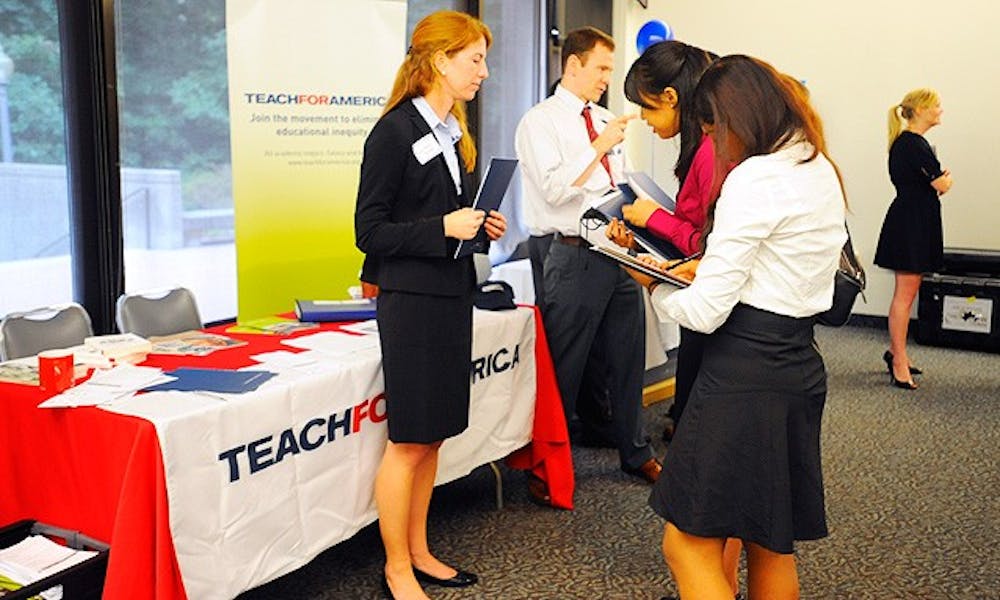One of the nation’s most lauded educational programs has recently felt some heat, but program officials and several participants who entered from Duke reject the criticism.
The Education and Public Interest Center at the University of Colorado at Boulder released a policy brief in June offering policy recommendations for policymakers considering hiring instructors through Teach for America. TFA pairs recent college graduates—normally without prior teaching experience, but often from elite universities—with poor performing schools. The program aims to lure some of America’s best students into teaching careers while simultaneously providing at-risk classrooms with the enthusiasm and energy of new graduates.
“Research on the impact of TFA teachers produces a mixed picture, with results affected by the experience level of the TFA teachers and the group of teachers with whom they are compared,” the report, titled “A Review of the Evidence,” notes. “There is little reason to expect any consensus on the question of relative effectiveness, or to expect test score data to quiet the debate.”
The document, compiled by Julian Vasquez Heilig and Su Jin Jez, draws on a number of studies performed on TFA between 2001 and 2010 that demonstrate the disagreement among experts over the program’s effectiveness. The report recommends that school districts only support TFA staffing when the alternative is employing uncertified instructors or emergency teachers and substitutes. Policymakers should recognize the “significant recurring costs of TFA”—the result of a high turnover rate among teachers—and consider other options that will serve schools in the long-term, the report notes.
Although the report finds that experience has a positive effect for both TFA and non-TFA teachers, the report notes that it is difficult to compare the performance of TFA teachers with other credentialed instructors.
Many graduates who participate in TFA do not intend on serving as teachers for their entire career. Although the experience of working for TFA before going into other sectors might increase social-conciousness, the report notes that the extent to which the TFA experience is responsible for this attitude remains unclear.
Several Duke TFA alumni, however, have found the experience indispensable. Duke boasts one of the largest representations in TFA this year, second to Northwestern University, TFA Regional Spokesperson Kaitlin Gastrock said.
Miho Kubagawa, Trinity ’07, was an economics major. Now a seventh grade math teacher, she disagrees with arguments that TFA fails to create teachers who remain active in education—teachers participating in TFA bring enthusiasm to the classroom.
“There’s something to be said about the energy that recent grads bring to the teaching profession,” Kubagawa said. “In my first year of teaching, I would get to school by 7 a.m. and would not leave until 7 p.m. with about two hours of work to do at home.”
With two children at home, research analyst Kevin Haynes, Trinity ’03 and a former participant of TFA, would not be able to commit to such a demanding schedule now. But the enthusiasm and willingness of recent graduates to dedicate themselves to a cause more than makes up for the perceived lack of teaching experience, Haynes said.
“Due to a lack of familial responsibilities at the time, compared to more experienced teachers that have families they are responsible for at home, it allows for most recent grads to give more time to their students,” he said.
Although the report estimates that 80 percent of TFA participants do not stay past three years, Gastrock said that 55 percent of TFA alumni are still teaching professionally. Gastrock also explained the importance of reviews by school principals that had TFA participants in their classrooms. She said 94 percent of principals surveyed said TFA corps members have made a positive impact in their school, and that almost as many found the TFA teachers to have training equaling or superseding that of professional teachers.
Some TFA alumni from Duke, however, do offer stories that support the program’s aim to foster a sense of educational responsibility in all of its participants—even those who do not pursue a career in education.
Kevin Fang, Trinity ’07, deferred admission from Case Western Reserve’s Medical School to have the TFA experience. After his commitment, Fang still remains an active advocate of education.
He partnered with a local high school to create a program that brings their students to the medical school campus. They follow medical students and doctors to see what life is like at that level of education. The students in his programs are shown ways to think critically and problem solve.
Although Fang did not stay on as a teacher, he has moved on to help education in a unique way. This summer, Fang will research the impact the program has on participants’ academic motivation and academic achievement.
“We want to show them that medical students aren’t special, magical geniuses, and that they can be medical students too, if they want,” he said. “By empowering [the students] in this way academically, our hope is that they are more motivated to succeed in their own school.”
Get The Chronicle straight to your inbox
Signup for our weekly newsletter. Cancel at any time.

